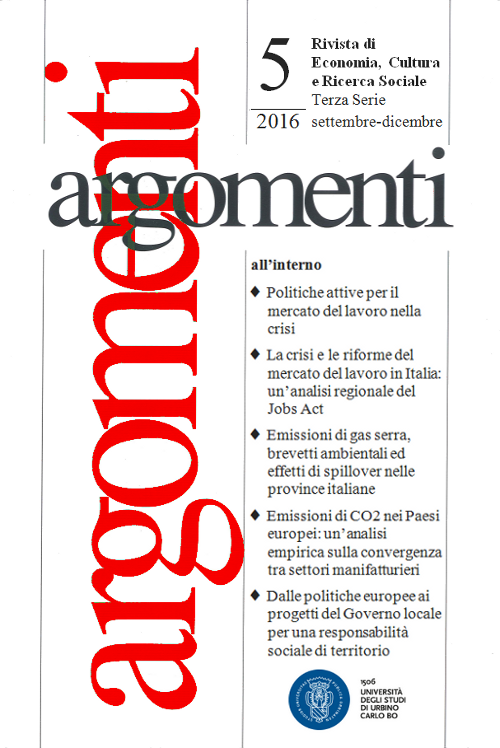Abstract
This paper provides an analysis of the dynamics of the Italian labor market after the introduction of the Jobs Act analyzing, in particular, the regional dimension. In line with the evidence shown in Fana et al. (2016), we show that, after the Jobs Act, temporary employment increased more than permanent one. Moreover, it emerges as the slight increase in employment is significantly linked to the stabilization of existing contracts rather than the creation of new employment. The dynamics of employment at the regional level is characterized by a significant degree of heterogeneity. However, no specific regional patterns seems to emerge. The empirical analysis is based on data on the labor force (ISTAT) distinguished by regions and on administrative data (INPS) concerning the quantity, quality and duration of employment contracts.
Riferimenti bibliografici
Bogliacino, F. e Pianta, M. 2016 The Pavitt Taxonomy, revisited: patterns of innovation in manufacturing and services Economia Politica – Journal of analytical and institutional economics. First online DOI: 10.1007/s40888-016-0035-1.
Brancati, R. 2015 MET Report 2015. Firms, markets and the State. Donzelli Eds. ISBN: 9788868432300.
Bronzini, R., Cannari, L., Staderini, A., Conti, L., D’Aurizio, L., Fabbrini, A., Filippone, A., Ilardi, G., Iuzzolino, G., Montanaro, P., Paccagnella, M., Pellegrini V. and Santioni, R. 2013 Industry in the South of Italy and the Crisis. Bank of Italy Occasional Paper, 2013, N° 194.
Cirillo V. e Guarascio D., 2014, Esiste una via d’uscita dalla crisi? Competitività, occupazione e declino industriale in Europa, «la Rivista delle Politiche Sociali », n. 4, pp. 189-209.
Cirillo V. e Guarascio D., 2015, Jobs and Competitiveness in a Polarised Europe, «Intereconomics», n. 50, pp. 156-160.
Fana, M., Guarascio, D., e Cirillo, V. 2016. Did Italy Need More Labour Flexibility?. Intereconomics, 51(2), 79-86.
Gallino, L. 2003 La scomparsa dell'Italia industriale. G. Einaudi editore, Torino.
Ginzburg A. e Simonazzi A., 2016, Rebalancing Europe as a way out of the crisis, «The European Journal of Comparative Economics», in via di pubblicazione.
Guarascio, D., e Simonazzi, A. 2016. A polarized country in a polarized Europe: an industrial policy for Italy’s renaissance. Economia e Politica Industriale, 1-8 DOI: 10.1007/s40812-016-0042-9.
Mazzucato M., Cimoli M. e. Dosi G., 2015, Which industrial policy does Europe need?, «Intereconomics», n. 50, pp. 120-155.
Pini, P. (2015). Il Jobs Act tra surrealismo e mistificazione: una lettura critica. Economia & lavoro, 49(2), pp. 177-216.
Pavitt, K. 1984. Sectoral patterns of technical change: towards a taxonomy and a theory. Research policy, 13(6), 343-373.
Sestito, P. e Viviano, E. 2016. Hiring incentives and/or firing cost reduction? Evaluating the impact of the 2015 policies on the Italian labour market, Questioni di Economia e Finanza (Occasional Papers) 325, Bank of Italy, Economic Research and International Relations Area.
Simonazzi A., Ginzburg A. e Nocella G., 2013, Economic relations between Germany and southern Europe, «Cambridge Journal of Economics», n. 37, pp. 653-675.
Svimez, 2015 Report on the economy of Southern Italy. Il Mulino Eds. 2015.
L'opera è pubblicata sotto Licenza Creative Commons - 4.0 International (CC BY 4.0)

